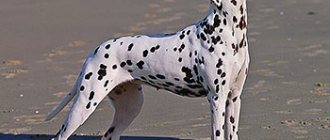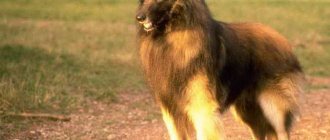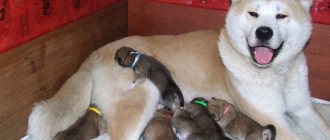From 0 to 2 weeks - neonatal period
This stage lasts about two weeks after birth, and the puppies remain blind and deaf during this time. They have no teeth and cannot control their own body temperature
The puppies will sleep almost constantly, but their mother will take care of all their needs: keeping them warm and clean, as well as feeding them.
Photos of 2-day-old Labrador puppies:
Photos of Labrador puppies 1 week:
And how did it turn out?
The Dwarf Labrador is a genetic mutation. It arose as a result of crossing a dwarf male and a standard female. The father's genes took over, resulting in undersized puppies.
Essentially, the Mini Labrador is a genetic marriage that carries no breeding value. Such dogs are not allowed to show, which means they are not suitable for breeding. You cannot breed Labradors that do not have an exhibition rating and permission for breeding.
From 2 to 4 weeks - transitional stage
Puppies will begin to open their eyes and respond to nearby lights, sounds and movement. During this period, they will also begin to go to the toilet on their own and begin teething.
You will also notice that the puppies begin to move more and more. And although at first they will mostly crawl, they will soon begin to walk and even run. The puppy will also begin to recognize its siblings and mother during this time. At some point he may even try his mother's regular food, but he will still need his mother's milk
Photos of Labrador puppies 2 weeks:
Photos of Labrador puppies 3 weeks:
From 3 to 4 weeks - development of feelings
At this time, the puppy will quickly develop all its senses. He will begin to recognize his environment, as well as people and all objects around him. At this stage, you must especially carefully protect the puppy's safety: from loud noises and other sudden situations that can greatly affect the development and character of the future dog.
It is extremely important that the puppy stays with its mother at this time and learns “how to be a dog” and how to interact with its own kind. Starting at 3 weeks of age, puppies learn:
- Basic behavioral patterns of dogs;
- The meaning of bites, and what it's like to be bitten;
- The meaning of various postures and their effect on other animals;
- The meaning of barking and other sounds;
- How to establish and develop relationships with other dogs.
Photos of Labrador puppies 4 weeks (1 month):
From 4 to 8 weeks (1-2 months) - socialization stage
Once the puppy reaches 4 weeks of age, he will begin to learn the most important things in his life related to social behavior. He will learn not to bite and interact with other dogs and animals.
Social interaction with people is especially important between the 5th and 8th weeks. During this time, the puppies will also learn discipline from their mother. She will begin to wean her puppies and teach them proper manners.
You can begin to gradually introduce regular food into your puppy's diet from about 4 weeks of age. Start with small amounts as the mother is still feeding them.
Make sure to exercise your puppy regularly every day. But do not separate him from his fellow dogs for more than 10 minutes, as this may lead to problems with socialization.
Dogs that have been separated from their mother and litter too early may be more nervous and bark and bite more often. Problems with further training and socialization can also often be attributed to puppies that are separated from their siblings too early.
Photos of Labrador puppies 1.5 months old:
Photos of Labrador puppies 2 months:
From 2 to 3 months - the second stage of socialization
During this period, puppies continue to hone their social skills and also go through a "fear" phase, where they are afraid and frightened by almost everything, including objects with which they were already familiar.
To soften this stage for puppies, avoid any traumatic situations, punishment, or loud noises. Make sure you and your pet have regular contact. During this time, you can also begin leash training and teaching basic, simple commands.
During this period, you should not take your puppy to areas where there are street or stray dogs as they may have diseases that can be fatal to your puppy. Long walks should wait until your pet has completed the full course of vaccinations.
Photos of Labrador puppies 3 months:
We bought a mini Labrador. Now what?
Did you fall for the ad and buy a dwarf Labrador puppy? What can you do, don’t get rid of it now. It's a pity, in the end, for the dog.
Here are some tips that those who have acquired a miniature Labrador will need:
- Be sure to see your dog at the veterinarian. Go through an examination with him, get tested. It is easier to identify diseases in advance than they will later appear at the wrong time and cause a lot of problems.
- Learn from a professional dog trainer. And throughout your pet's life, do not lose contact with the trainer. You never know when the dog gets crossed.
- We are responsible for those we have tamed. This is a hackneyed phrase, but it is relevant at all times. Of course, it is very disappointing to buy a dog that will not be able to participate in exhibitions. Especially if it was bought with such an expectation. Well what to do now? It's not the dog's fault that his breeders turned out to be liars.
From 2 to 4 months - “teenage” period
At this stage, your puppy can be compared to a teenager. He will become more independent and may even begin to ignore your commands. If this happens, be firm and consistent, but also gentle enough, and reinforce commands and other training.
You will likely notice that your puppy will begin to test your authority by lightly biting you or playing similar games. You should stop this behavior by firmly saying “no” and ignoring your puppy for a few minutes.
Continue to play with your puppy regularly, but don't fight him. Otherwise, you can teach him that fighting you is good, and then sooner or later he will challenge your authority.
Photos of Labrador puppies 4 months:
Where are they sold?
Fortunately, breeders of dwarf Labradors (pictured) do not advertise their nurseries too much. Because they understand that unpleasant consequences of such “PR” await them. Most often, such individuals live on various free sites. There they have freedom, they advertise their “kennels”, describe how wonderful dogs are miniature Labradors, and sell this genetic marriage. Moreover, they ask for very decent amounts. From 30,000 thousand and above. They even provide pedigrees of the puppies' parents. And puppy cards are issued to future owners.
There is no point in buying such a puppy. You can’t visit exhibitions with him, because his pedigree is fake. One can only guess what problems with mental and physical health may arise. Such a dog will cause more problems than the joy of acquiring it.
From 3 to 6 months - social dominance
During this period, the puppy is more likely to start trying to show dominance over children and other members of your family. He will watch you and other people very carefully, selecting appropriate human reactions.
The puppy will begin to learn the hierarchy in his pack (family) and will try to figure out where he is in this hierarchy.
Starting at 3 months, the puppy will begin to:
- question authority
- try to dominate animals and people
- grab the leash
- growl periodically
Counteract this by continuing obedience and basic command training. If the puppy becomes agitated or aggressive, simply stop any activity with him. Your dog's molars will also begin to come out during this time, so give him plenty of toys that he can chew safely.
Photos of Labrador puppies 5 months:
Photos of Labrador puppies 6 months:
From 6 to 18 months - young dog
Starting at 6 months, your puppy is already in the final stages of his development, but he is still very young. At this time, the puppy will be full of energy and will continue to explore the world around him.
It's important to remember that your buddy is still a puppy, even though he looks like an adult dog. You can start working on advanced levels of training, or continue training him to interact in a non-aggressive manner with other animals and people.
It is also likely that your dog will go through another "fear" stage after reaching 6 months. Not all Labradors experience this stage again, but if it does, you know what to do.
Photo of Labrador 1 year:
Wonderful miracle, wonderful miracle
The miniature Labrador is the unfortunate result of mad breeding by scientists. Dear dog loving readers, never, under any circumstances, purchase a toy Labrador. Remember that by purchasing this dog, you are sponsoring unscrupulous breeders.
Where do such bold conclusions come from? This is because small Labradors do not exist as a separate breed. It's just that someone very smart realized that people like these dogs. Only they are very large, which means they are not always convenient for keeping in an apartment. This “someone” decided to reduce the size of the representatives of the breed. How? More on this in the next paragraph.
Latest tips
Now that you know what stage of development your puppy is at, you can better meet his needs. Provide him with plenty of social contact with his siblings, as well as people and other types of pets.
Your dog should reach physical and emotional maturity between 1 and 2 years of age, depending on the type of Labrador you have. Since there are many types and varieties of Labradors, they are considered fully mature between 2 and 2.5 years of age.
There should be a description here
But he won't be there. The difference from the usual representative of the breed in the dwarf Labrador is in height. He is 15-20 centimeters lower than usual.
Now imagine what it looks like? Taking into account the fact that the breed standard clearly states: the height of a male varies from 57 to 62 centimeters. And female dogs should not exceed 60 centimeters. One can only feel sorry for the miniature Labrador.










